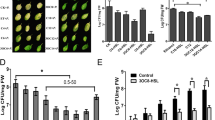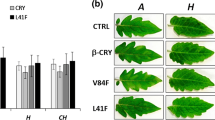Abstract
Main conclusion
N-decanoyl-homoserine lactone activates plant systemic resistance against Botrytis cinerea in tomato plants, which is largely dependent on jasmonic acid biosynthesis and signal transduction pathways.
Rhizosphere bacteria secrete N-acylated-homoserine lactones (AHLs), a type of specialized quorum-sensing signal molecule, to coordinate their population density during communication with their eukaryotic hosts. AHLs behave as low molecular weight ligands that are sensed by plants and promote the host’s resistance against foliar pathogens. In this study, we report on N-decanoyl-homoserine lactone (DHL), which is a type of AHL that induces systemic immunity in tomato plants and protects the host organism against the necrotrophic fungus Botrytis cinerea. Upon DHL treatment, tomato endogenous jasmonic acid (JA) biosynthesis (rather than salicylic acid biosynthesis) and signal transduction were significantly activated. Strikingly, the DHL-induced systemic resistance against B. cinerea was blocked in the tomato JA biosynthesis mutant spr2 and JA signaling gene-silenced plants. Our findings highlight the role of DHL in systemic resistance against economically important necrotrophic pathogens and suggest that DHL-induced immunity against B. cinerea is largely dependent on the JA signaling pathway. Manipulation of DHL-induced resistance is an attractive disease management strategy that could potentially be used to enhance disease resistance in diverse plant species.






Similar content being viewed by others
Abbreviations
- AHLs:
-
N-acylated-homoserine lactones
- DHL:
-
N-decanoyl-homoserine lactone
- dpi/hpi:
-
Day/hour post infection
- HHL:
-
N-hexanoyl-homoserine lactone
- JA:
-
Jasmonic acid
- OHHL:
-
N-3-oxo-hexanoyl-homoserine lactone
- PI:
-
Proteinase inhibitor
- SA:
-
Salicylic acid
- ФPSII:
-
The photochemical quantum efficiency of PSII
References
Asai S, Mase K, Yoshioka H (2010) A key enzyme for flavin synthesis is required for nitric oxide and reactive oxygen species production in disease resistance. Plant J 62(6):911–924
Birkenbihl RP, Diezel C, Somssich IE (2012) Arabidopsis WRKY33 is a key transcriptional regulator of hormonal and metabolic responses toward Botrytis cinerea infection. Plant Physiol 159(1):266–285
Bolton MD, Thomma BPHJ, Nelson BD (2006) Sclerotinia sclerotiorum (Lib.) de Bary: biology and molecular traits of a cosmopolitan pathogen. Mol Plant Pathol 7(1):1–16
de Oliveira MVV, Xu GY, Li B, Vespoli LD, Meng XZ, Chen X, Yu X, de Souza SA, Intorne AC, Manhaes AMED, Musinsky AL, Koiwa H, de Souza GA, Shan LB, He P (2016) Specific control of Arabidopsis BAK1/SERK4-regulated cell death by protein glycosylation. Nat Plants 2(2):15218
El Oirdi M, Abd El Rahman T, Rigano L, El Hadrami A, Rodriguez MC, Daayf F, Vojnov A, Bouarab K (2011) Botrytis cinerea manipulates the antagonistic effects between immune pathways to promote disease development in tomato. Plant Cell 23(6):2405–2421
Ferrari S, Plotnikova JM, De Lorenzo G, Ausubel FM (2003) Arabidopsis local resistance to Botrytis cinerea involves salicylic acid and camalexin and requires EDS4 and PAD2, but not SID2, EDS5 or PAD4. Plant J 35(2):193–205
Ferrari S, Galletti R, Denoux C, De Lorenzo G, Ausubel FM, Dewdney J (2007) Resistance to Botrytis cinerea induced in Arabidopsis by elicitors is independent of salicylic acid, ethylene, or jasmonate signaling but requires PHYTOALEXIN DEFICIENT3. Plant Physiol 144(1):367–379
Fonseca S, Chico JM, Solano R (2009) The jasmonate pathway: the ligand, the receptor and the core signalling module. Curr Opin Plant Biol 12(5):539–547
Fu ZQ, Dong XN (2013) Systemic acquired resistance: turning local infection into global defense. Annu Rev Plant Biol 64(64):839–863
Gaida MM, Dapunt U, Hansch GM (2016) Sensing developing biofilms: the bitter receptor T2R38 on myeloid cells. Pathog Dis 74(3):ftw004
Genty B, Briantais JM, Baker NR (1989) The relationship between the quantum yield of photosynthetic electron-transport and quenching of chlorophyll fluorescence. Biochim Biophys Acta 990(1):87–92
Glazebrook J (2005) Contrasting mechanisms of defense against biotrophic and necrotrophic pathogens. Annu Rev Phytopathol 43:205–227
Gonzalez JE, Keshavan ND (2006) Messing with bacterial quorum sensing. Microbiol Mol Biol Rev 70(4):859–875
Gotz C, Fekete A, Gebefuegi I, Forczek ST, Fuksova K, Li X, Englmann M, Gryndler M, Hartmann A, Matucha M, Schmitt-Kopplin P, Schroder P (2007) Uptake, degradation and chiral discrimination of N-acyl-d/l-homoserine lactones by barley (Hordeum vulgare) and yam bean (Pachyrhizus erosus) plants. Anal Bioanal Chem 389(5):1447–1457
Govrin EM, Levine A (2002) Infection of Arabidopsis with a necrotrophic pathogen, Botrytis cinerea, elicits various defense responses but does not induce systemic acquired resistance (SAR). Plant Mol Biol 48(3):267–276
Karlsson T, Turkina MV, Yakymenko O, Magnusson KE, Vikstrom E (2012) The Pseudomonas aeruginosa N-acylhomoserine lactone quorum sensing molecules target IQGAP1 and modulate epithelial cell migration. PLoS Pathog 8(10):e1002953
Lade H, Paul D, Kweon JH (2014) N-acyl homoserine lactone-mediated quorum sensing with special reference to use of quorum quenching bacteria in membrane biofouling control. Biomed Res Int 2014:16254
Li CY, Liu GH, Xu CC, Lee GI, Bauer P, Ling HQ, Ganal MW, Howe GA (2003) The tomato Suppressor of prosystemin-mediated responses2 gene encodes a fatty acid desaturase required for the biosynthesis of jasmonic acid and the production of a systemic wound signal for defense gene expression. Plant Cell 15(7):1646–1661
Liu YL, Schiff M, Dinesh-Kumar SP (2002) Virus-induced gene silencing in tomato. Plant J 31(6):777–786
Livak KJ, Schmittgen TD (2001) Analysis of relative gene expression data using real-time quantitative PCR and the 2−ΔΔCT method. Methods 25(4):402–408
Lopez-Millan AF, Sagardoy R, Solanas M, Abadia A, Abadia J (2009) Cadmium toxicity in tomato (Lycopersicon esculentum) plants grown in hydroponics. Environ Exp Bot 65(2–3):376–385
Mathesius U, Mulders S, Gao MS, Teplitski M, Caetano-Anolles G, Rolfe BG, Bauer WD (2003) Extensive and specific responses of a eukaryote to bacterial quorum-sensing signals. Proc Natl Acad Sci USA 100(3):1444–1449
Morquecho-Contreras A, Mendez-Bravo A, Pelagio-Flores R, Raya-Gonzalez J, Ortiz-Castro R, Lopez-Bucio J (2010) Characterization of drr1, an alkamide-resistant mutant of Arabidopsis, reveals an important role for small lipid amides in lateral root development and plant senescence. Plant Physiol 152(3):1659–1673
Ortiz-Castro R, Martinez-Trujillo M, Lopez-Bucio J (2008) N-acyl-l-homoserine lactones: a class of bacterial quorum-sensing signals alter post-embryonic root development in Arabidopsis thaliana. Plant Cell Environ 31(10):1497–1509
Pieterse CMJ, Leon-Reyes A, Van der Ent S, Van Wees SCM (2009) Networking by small-molecule hormones in plant immunity. Nat Chem Biol 5(5):308–316
Pieterse CMJ, Zamioudis C, Berendsen RL, Weller DM, Van Wees SCM, Bakker PAHM (2014) Induced systemic resistance by beneficial microbes. Annu Rev Phytopathol 52:347–375
Rehman S, Aziz E, Akhtar W, Ilyas M, Mahmood T (2017) Structural and functional characteristics of plant proteinase inhibitor-II (PI-II) family. Biotechnol Lett 39(5):647–666
Rowe HC, Walley JW, Corwin J, Chan EKF, Dehesh K, Kliebenstein DJ (2010) Deficiencies in jasmonate-mediated plant defense reveal quantitative variation in Botrytis cinerea pathogenesis. PLoS Pathog 6(4):e1000861
Schenk ST, Hernandez-Reyes C, Samans B, Stein E, Neumann C, Schikora M, Reichelt M, Mithofer A, Becker A, Kogel KH, Schikora A (2014) N-acyl-homoserine lactone primes plants for cell wall reinforcement and induces resistance to bacterial pathogens via the salicylic acid/oxylipin pathway. Plant Cell 26(6):2708–2723
Schikora A, Schenk ST, Stein E, Molitor A, Zuccaro A, Kogel KH (2011) N-acyl-homoserine lactone confers resistance toward biotrophic and hemibiotrophic pathogens via altered activation of AtMPK6. Plant Physiol 157(3):1407–1418
Schuhegger R, Ihring A, Gantner S, Bahnweg G, Knappe C, Vogg G, Hutzler P, Schmid M, Van Breusegem F, Eberl L, Hartmann A, Langebartels C (2006) Induction of systemic resistance in tomato by N-acyl-l-homoserine lactone-producing rhizosphere bacteria. Plant Cell Environ 29(5):909–918
Sun JQ, Jiang HL, Li CY (2011) Systemin/jasmonate-mediated systemic defense signaling in tomato. Mol Plant 4(4):607–615
Tejeda-Sartorius M, de la Vega OM, Delano-Frier JP (2008) Jasmonic acid influences mycorrhizal colonization in tomato plants by modifying the expression of genes involved in carbohydrate partitioning. Physiol Plant 133(2):339–353
van Loon LC, Bakker PAHM, Pieterse CMJ (1998) Systemic resistance induced by rhizosphere bacteria. Annu Rev Phytopathol 36:453–483
Vannini A, Volpari C, Gargioli C, Muraglia E, Cortese R, De Francesco R, Neddermann P, Di Marco S (2002) The crystal structure of the quorum sensing protein TraR bound to its autoinducer and target DNA. EMBO J 21(17):4393–4401
Vlot AC, Dempsey DA, Klessig DF (2009) Salicylic acid, a multifaceted hormone to combat disease. Annu Rev Phytopathol 47:177–206
von Rad U, Klein I, Dobrev PI, Kottova J, Zazimalova E, Fekete A, Hartmann A, Schmitt-Kopplin P, Durner J (2008) Response of Arabidopsis thaliana to N-hexanoyl-dl-homoserine-lactone, a bacterial quorum sensing molecule produced in the rhizosphere. Planta 229(1):73–85
Walters DR, Ratsep J, Havis ND (2013) Controlling crop diseases using induced resistance: challenges for the future. J Exp Bot 64(5):1263–1280
Waters CM, Bassler BL (2005) Quorum sensing: cell-to-cell communication in bacteria. Annu Rev Cell Dev Biol 21:319–346
Waters CA, Lu WY, Rabinowitz JD, Bassler BL (2008) Quorum sensing controls biofilm formation in Vibrio cholerae through modulation of cyclic Di-GMT levels and repression of vpsT. J Bacteriol 190(7):2527–2536
Williamson B, Tudzynsk B, Tudzynski P, van Kan JAL (2007) Botrytis cinerea: the cause of grey mould disease. Mol Plant Pathol 8(5):561–580
Withers H, Swift S, Williams P (2001) Quorum sensing as an integral component of gene regulatory networks in Gram-negative bacteria. Curr Opin Microbiol 4(2):186–193
Wu JQ, Hettenhausen C, Meldau S, Baldwin IT (2007) Herbivory rapidly activates MAPK signaling in attacked and unattacked leaf regions but not between leaves of Nicotiana attenuata. Plant Cell 19(3):1096–1122
Zabala MD, Zhai B, Jayaraman S, Eleftheriadou G, Winsbury R, Yang R, Truman W, Tang SJ, Smirnoff N, Grant M (2016) Novel JAZ co-operativity and unexpected JA dynamics underpin Arabidopsis defence responses to Pseudomonas syringae infection. New Phytol 209(3):1120–1134
Zhang S, Li X, Sun ZH, Shao SJ, Hu LF, Ye M, Zhou YH, Xia XJ, Yu JQ, Shi K (2015) Antagonism between phytohormone signalling underlies the variation in disease susceptibility of tomato plants under elevated CO2. J Exp Bot 66(7):1951–1963
Zhu ZQ, An FY, Feng Y, Li PP, Xue L, Mu A, Jiang ZQ, Kim JM, To TK, Li W, Zhang XY, Yu Q, Dong Z, Chen WQ, Seki M, Zhou JM, Guo HW (2011) Derepression of ethylene-stabilized transcription factors (EIN3/EIL1) mediates jasmonate and ethylene signaling synergy in Arabidopsis. Proc Natl Acad Sci USA 108(30):12539–12544
Acknowledgements
This work was supported by the National Key Research and Development Program of China (2017YFD0200600) and the National Natural Science Foundation of China (31772355).
Author information
Authors and Affiliations
Corresponding author
Electronic supplementary material
Below is the link to the electronic supplementary material.
Rights and permissions
About this article
Cite this article
Hu, Z., Shao, S., Zheng, C. et al. Induction of systemic resistance in tomato against Botrytis cinerea by N-decanoyl-homoserine lactone via jasmonic acid signaling. Planta 247, 1217–1227 (2018). https://doi.org/10.1007/s00425-018-2860-7
Received:
Accepted:
Published:
Issue Date:
DOI: https://doi.org/10.1007/s00425-018-2860-7




